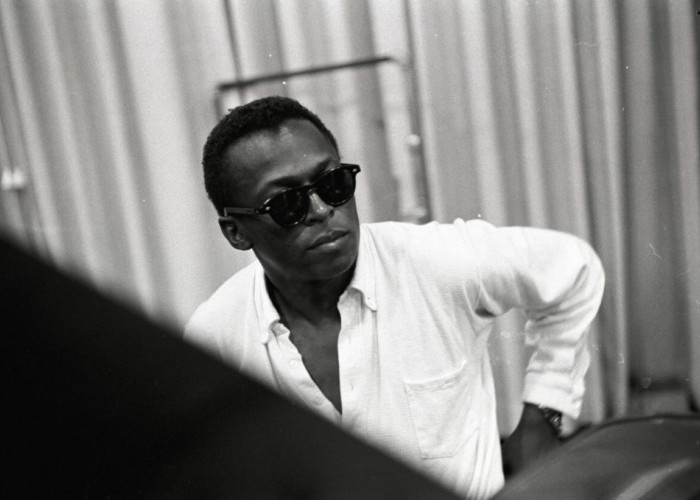Oct 28, 2025 10:47 AM
In Memoriam: Jack DeJohnette, 1942–2025
Jack DeJohnette, a bold and resourceful drummer and NEA Jazz Master who forged a unique vocabulary on the kit over his…

Miles Davis during the ’Round About Midnight sessions in June 1956
(Photo: Don Hunstein/Sony Music Archives/Courtesy of Abramorama/Eagle Rock)Miles Davis was a difficult man. Even those who are passingly familiar with his biography know that to be true.
He was an on-again, off-again drug addict for much of his life—heroin and cocaine being his primary lures. He had a terrible temper. He was violent. He was extremely paranoid. He was often in pain. If he didn’t like you, you were a “motherfucker”—and if he did like you, then maybe you were a “motherfucker,” too.
Filmmaker Stanley Nelson’s new documentary, Miles Davis: Birth of the Cool, doesn’t shy away from that side of Davis. It’s a part of the trumpeter that’s inseparable from his allure, his understated charisma. How could such a troubled man have produced such beautiful music? That’s always been the question when considering Davis’ work, and Nelson doesn’t necessarily seek to answer it. He does, however, throw the question into relief, poking and prodding it, drawing out Davis’ many contradictions. The film has a spare and quiet vibe; it embodies the loneliness, the sense of alienation, that Davis seemed to have felt all his life.
“Not only is Miles’ music incredible—it spans so many eras, and it’s so influential. But Miles is also just a fascinating character and individual,” Nelson said, a few days before the movie’s Aug. 23 premiere at Manhattan’s Film Forum. Beginning in September, the film opens in select theaters nationwide. Nelson, whose previous documentaries include The Murder of Emmett Till and Jonestown: The Life and Death of Peoples Temple, said that he always had wanted to make a documentary about a jazz musician—“and who’s better than to make a film about than Miles?”
The movie follows, in chronological fashion, the peaks and troughs of the trumpeter’s life, beginning with his relatively privileged upbringing in East St. Louis, Illinois. It’s meant for initiates, but there still are some surprises for those who already are familiar with his work. We learn, for instance, that a young Davis liked to go into the woods and listen to the animals and play what he was hearing—a practice reminiscent of multi-reedist Eric Dolphy, who was known to imitate bird song and whom Davis once called a “sad motherfucker.”
Nelson lingers on Davis’ vast musical oeuvre, but it never feels as if he is checking anything off a list. Perhaps that’s because the movie is, in parts, narrated by an actor whose raspy voice serves as a stand-in for Davis. This gives the film an emotional weight that reinforces the narrative. Nelson also leaves ample room for the music itself, letting at least one song play in its entirety. (Nelson said he listened exclusively to Davis’ music for two years while making the film.) Additionally, there is never-before-seen archival footage that helps to humanize the man whose music shaped the evolution of jazz itself, from the time he first moved to New York in 1944 until his death in 1991 at age 65.

Jack DeJohnette boasted a musical resume that was as long as it was fearsome.
Oct 28, 2025 10:47 AM
Jack DeJohnette, a bold and resourceful drummer and NEA Jazz Master who forged a unique vocabulary on the kit over his…

D’Angelo achieved commercial and critical success experimenting with a fusion of jazz, funk, soul, R&B and hip-hop.
Oct 14, 2025 1:47 PM
D’Angelo, a Grammy-winning R&B and neo-soul singer, guitarist and pianist who exerted a profound influence on 21st…

To see the complete list of nominations for the 2026 Grammy Awards, go to grammy.com.
Nov 11, 2025 12:35 PM
The nominations for the 2026 Grammy Awards are in, with plenty to smile about for the worlds of jazz, blues and beyond.…

Drummond was cherished by generations of mainstream jazz listeners and bandleaders for his authoritative tonal presence, a defining quality of his style most apparent when he played his instrument unamplified.
Nov 4, 2025 11:39 AM
Ray Drummond, a first-call bassist who appeared on hundreds of albums as a sideman for some of the top names in jazz…

Jim McNeely’s singular body of work had a profound and lasting influence on many of today’s top jazz composers in the U.S. and in Europe.
Oct 7, 2025 3:40 PM
Pianist Jim McNeely, one of the most distinguished large ensemble jazz composers of his generation, died Sept. 26 at…





